Key Measurements for Entrances Great and Small
http://decor-ideas.org 12/30/2014 01:13 Decor Ideas
Entrance areas are often given less priority when a home is being designed, but these spaces are just as important as any other. You will likely use them far more often than you realize. Not only do they provide an entry point and a transition from the elements of nature, but they are places your guests will likely remember most — the first impressions.
Entrances also allow you to enter your lair and embrace your private life. For that they must let you remove a coat, take off shoes, set down mail, stow an umbrella, greet your friends or do any other activity that involves arriving at home. What is fascinating about them is that they can accomplish these tasks in grand or simple ways, either in scale or decoration.
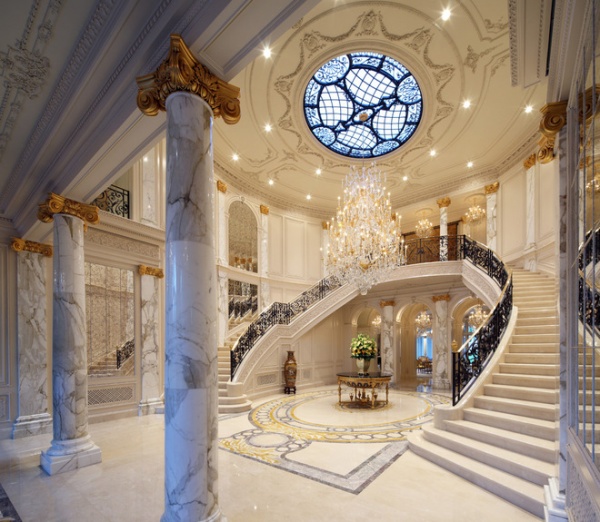
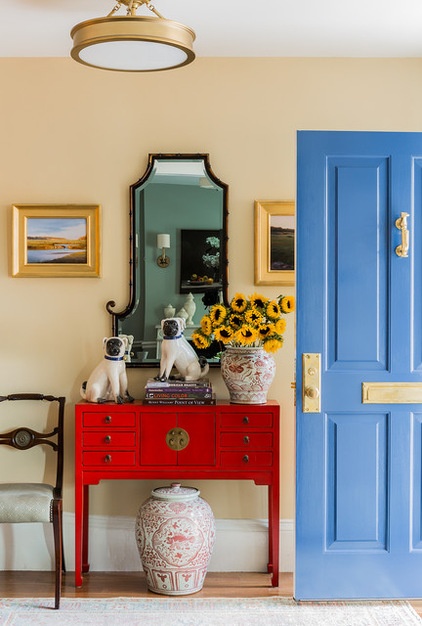
Relative Scale
These two photos may initially appear dissimilar; however, they are more alike than you might realize. Scale is the differentiator, but they are both rooted in traditional architecture and they function similarly.
An entrance door is centered within each foyer and each has a chandelier, albeit of considerably different magnitudes. Each also has a beautiful table, upon which rests a vase of flowers. Mirrors allow the play of light and provide reflection, and color adds emphasis. These elements are common to many entries. Attention to the scale of the details and the execution of the design make them successful here.
Grand foyers of the type shown in the first photo can measure 20 to 30 feet (6 to 9 meters) in both directions and be just as high. Its modestly scaled cousin in the second photo is about 5½ ft. (1½ m) wide; the length, which holds a central hall with a stairway (not seen here) is likely 15 to 20 ft. (4½ to 6 m).
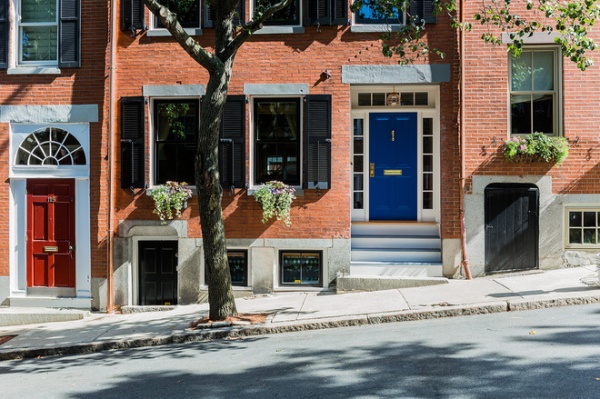
Here’s an exterior view of this entrance door with its transom and sidelights.
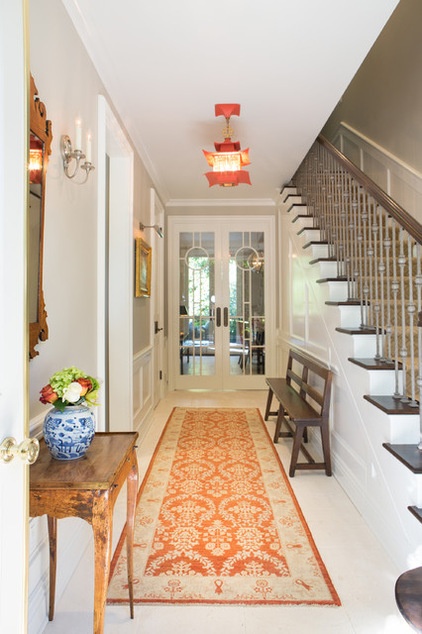
Wide or Narrow
Shapes and sizes of foyers should relate to the style and size of the house. A large two-story volume that expresses the grandeur of the residence forms the foyer in the first example, while the second example and the one shown here are narrow and long leading to the entrance door and imply more modest abodes.
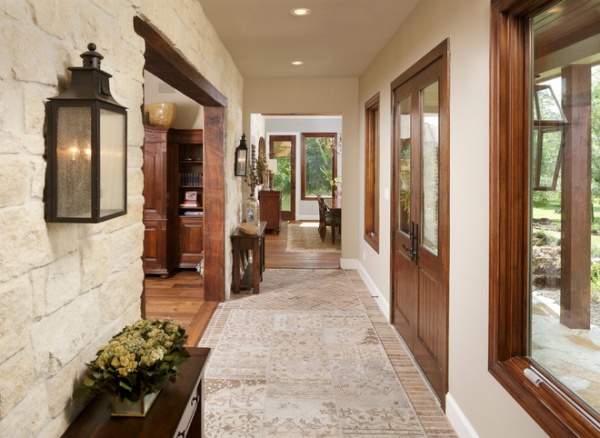
This entrance is shallow and wide (the front door is to the right) and relates to the ranch style of the home. A good rule of thumb is that the foyer is around 2 to 4 percent of the total square feet or meters of your house.
Most people also need a coat closet within or immediately adjacent to this space, and that should be 24 inches (61 centimeters) deep and at least 36 in. (91 cm) wide with doors that are at least 24 in. (61 cm) wide and 80 in. (203 cm) tall. If you design a wide coat closet — say, more than 48 in. (122 cm) — give it a double door of at least 18 in. (46 cm) per panel. This will make access to its interior more convenient.
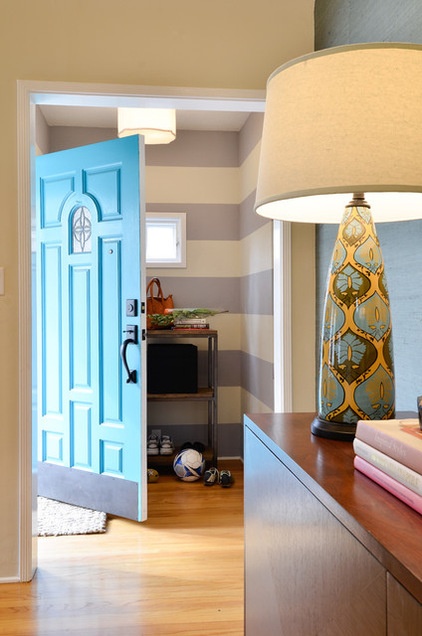
Single and Double Doors
This California bungalow has a typically modest foyer and entrance door. Many entrance doors in American houses are 36 in. (91 cm) wide and 80 in. (203 cm) tall, like this one.
If you are shopping for a replacement, you will find an abundant range of choices in this size. As shown in the previous example, double doors are another option, provided you have the space for them. You can find pairs that are 30 in. (76 cm) each, making an opening that is 60 in. (152 cm) wide. More common is a pair of doors that are each 36 in. (91 cm). At 6 ft. (2 m) in width total, it takes generous wall space and a larger-than-average foyer to handle them.
Double doors are designed with an active side and a passive side — that is, one of the doors will act as the one you most frequently open. The other door is considered passive, though it can be opened as well, but it stays in place most of the time. When specifying double doors, be certain to consider this question carefully. It often makes a difference as to which side you will want to open more often.
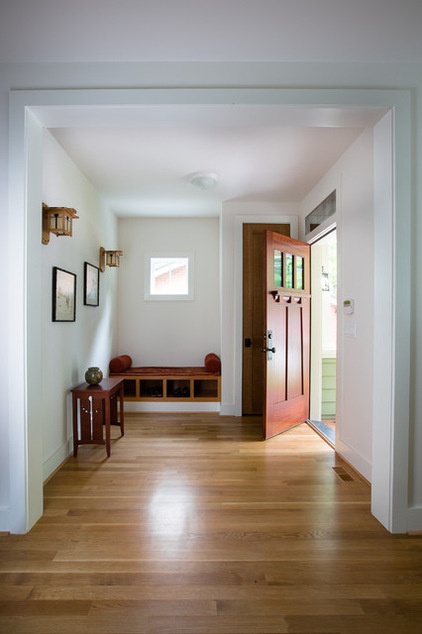
Common Sizes
This new traditional Craftsman house also has a common entrance door, 36 in. (91 cm) wide and 80 in. (203 cm) tall, and there is also a transom above it that helps it to relate to the taller door of the coat closet.
The overall size of this foyer is generous and includes a built-in bench where shoes can be removed. The seat height of a bench should be around 14 to 15 in. (36 to 38 cm). Notice that the coat closet door is relatively narrow. As mentioned, doors narrower than 24 in. (61 cm) can be difficult to find off the shelf.
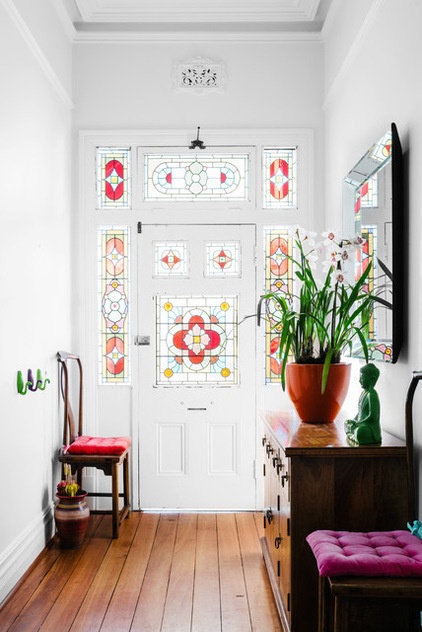
Sidelights and Transoms
Sidelights and transoms can be found in many traditional configurations, as seen in this foyer in Perth, Western Australia. Traditional-style American sidelights are usually 12 or 18 in. (30 or 46 cm) wide, and transoms will fit in a header height of 96 in. (244 cm) when combined with an 80-in. (203-cm) door.
You can buy an entire single door or set of double door and sidelight(s), with or without transoms, in a packaged group from many manufacturers. Expect these doors to range from 60 to 96 in. (152 to 244 cm) in width and from 80 to 120 in. (203 to 304 cm) in height.
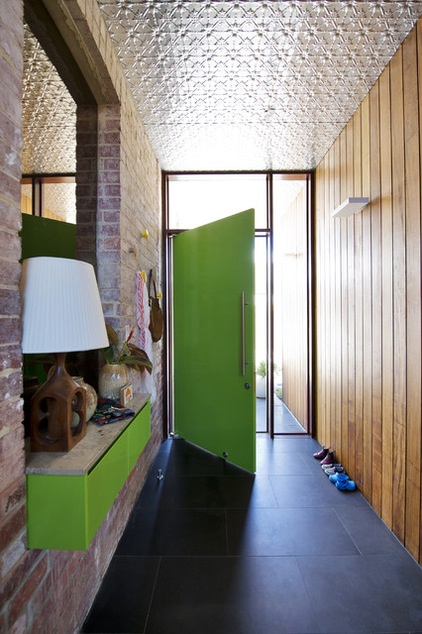
Foyer Width
Contemporary architecture can interpret traditional configurations, as shown in this Australian addition, also in Perth. A sidelight and transom of a single pane each accompany the colorful slab entrance door. This long and narrow foyer pays homage to the original 1920s bungalow to which it was added with its embossed ceiling and exposed brick.
The tile floor and vertical teak cladding of the opposite wall smartly transition to the modern-style addition. Consider that the width of a long foyer needs to be a minimum of 42 in. (107 cm) to feel right. Widths of 48 to 54 in. (122 to 137 cm) are better, while 60 to 72 in. (152 to 183 cm) will likely feel very generous. Here a niche in the brick wall, which was once an opening into the original house, provides a spot for a lamp and other accessories.
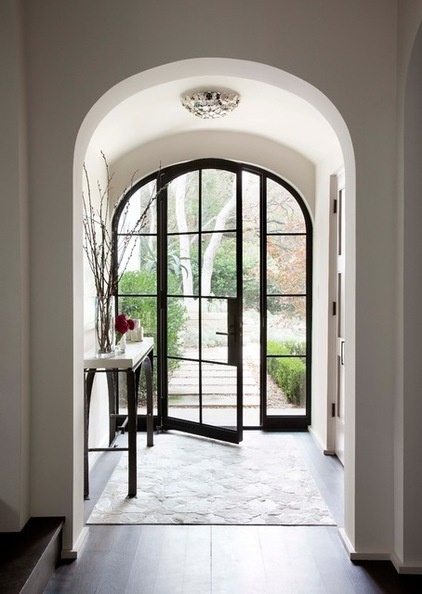
Archways
The next four examples have in common an arch that defines the extent of the foyer. They all employ a sidelight and three of them have a transom. Seen here is the first, in a contemporary Mediterranean home; it is modestly scaled but highly refined in detail.
The arched glass entrance door with sidelights was likely custom fabricated, and a unique low and square baseboard gives this space individuality. This arrangement measures about 66 to 72 in. (168 to 183 cm) wide and 72 to 96 in. (183 to 244 cm) long. The narrow table provides a place for accessories.
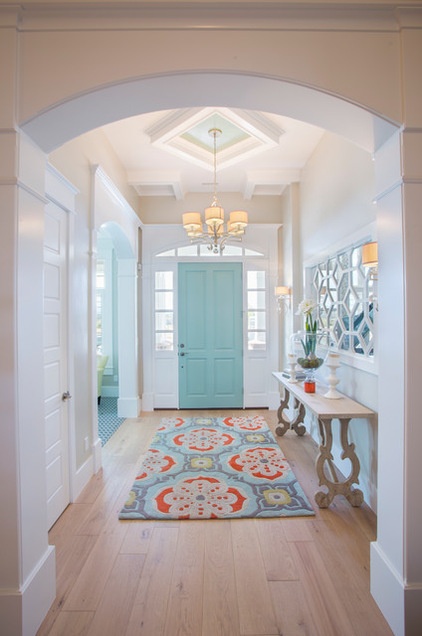
In this transitional-style house, two interior arches are reflected in the transom. Sidelights with glazed upper sections and a paneled lower one complement the four-panel entrance door. This foyer is about 72 in. (183 cm) wide and runs approximately the length of the adjacent room, about 15 ft. (4½ m). Notice that a closet is at left, conveniently placed aside the footprint of the foyer. A long and narrow table lines the opposite wall and provides a place on which to set things.
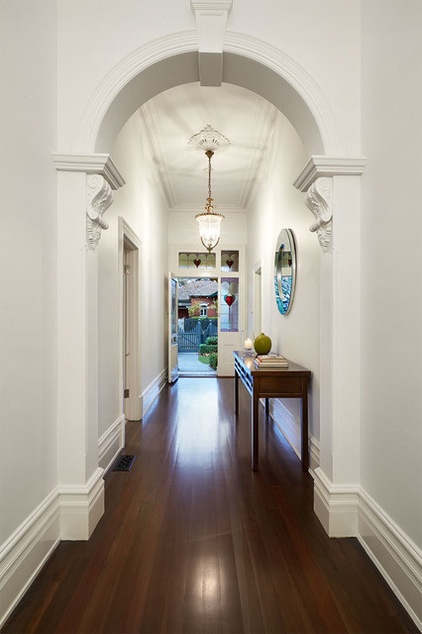
Ceiling Heights
Traveling back Down Under to Melbourne, we find a marvelously detailed Victorian foyer that is long and narrow and terminated by an archway with imposts, the molding that underlines the arch, supported by scrolls. Part of its charm is the tall ceiling, which is around 12 ft. (3½ m). Standard American ceilings were 8 feet for many years, but more recent trends have made 9- and 10-foot ceilings more common. Of course, you may have a two-story house with an open foyer, and your ceiling may reach the height of the second floor, which would be a minimum of 17 ft. (5 m) to the full height of the upper level.
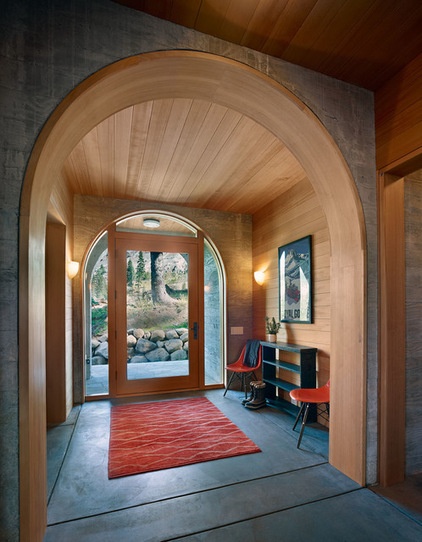
Wall Thickness
This contemporary rustic mountain home in a California ski resort area has a wide glass entrance door set within arched sidelights and an arched transom. Configurations like this are custom. The refined details of the finishes and the scores in the concrete floor give this modern space unique character.
In each of these four examples, you will notice that the interior arches are thicker than the other walls. This may or may not be for structural reasons, but the heft of this detail emphasizes the foyer’s importance. If you want this affect, make those walls at least 8 in. (20 cm) and at most 18 in. (46 cm) thick; 12 in. (30 cm) might work well enough.
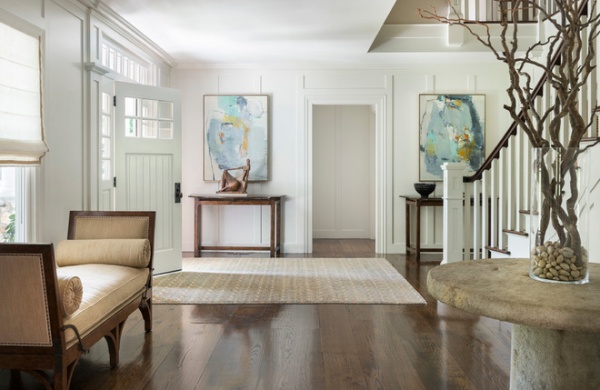
Generous Traditional Foyer
The traditional Connecticut foyer shown here is generously proportioned and acts as a central circulation route as well. The spacious room has an area for the entrance door, a landing for the stairs, places for tables on which to set things, and benches and chairs. A foyer of this type needs to be 15 to 20 ft. (4½ to 6 m) wide and long to function with this capacity. Notice the extra-wide plank floors, which coordinate with the larger scale of the space.
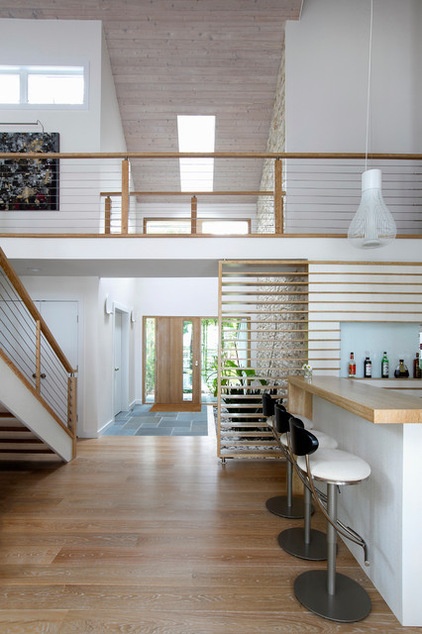
Generous Contemporary Foyer
This airy contemporary entrance hall in New York gets more light from a skylight in the upper-level roof. A bridge helps to define the extent of the foyer and provides a scenic vantage point from which to enjoy the interior plants and stone wall from above. Notice the slate floor as another indication of this foyer’s extent.
More:
Designer’s Touch: 10 First-Class Foyers
Key Measurements to Help You Design Your Kitchen
Related Articles Recommended












